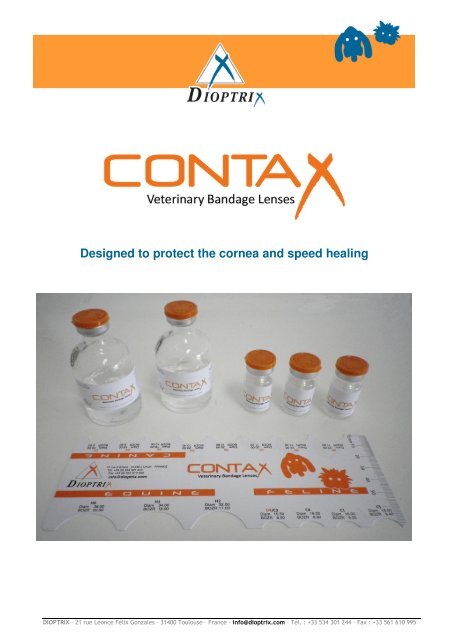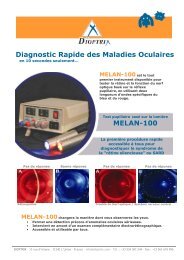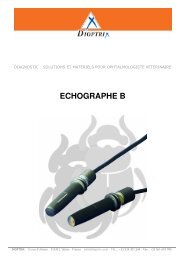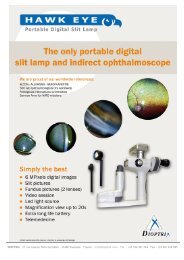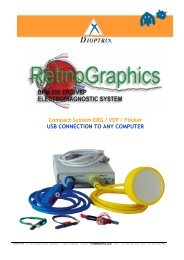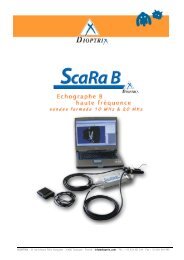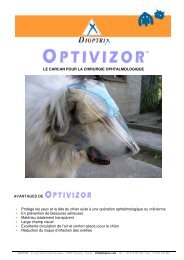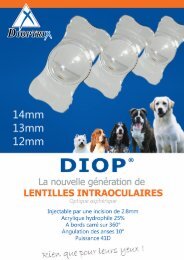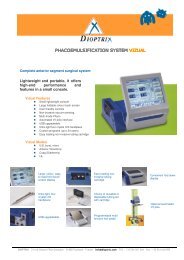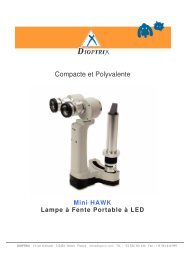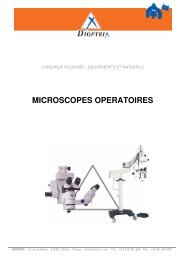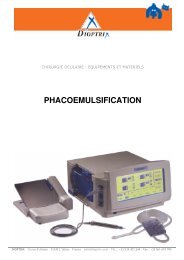CONTAX - Veterinary - Dioptrix
CONTAX - Veterinary - Dioptrix
CONTAX - Veterinary - Dioptrix
You also want an ePaper? Increase the reach of your titles
YUMPU automatically turns print PDFs into web optimized ePapers that Google loves.
Designed to protect the cornea and speed healing<br />
DIOPTRIX – 21 rue Léonce Félix Gonzales – 31400 Toulouse – France – info@dioptrix.com – Tél. : +33 534 301 244 – Fax : +33 561 610 995
CAT<br />
COMFORT – PROTECTION - FLEXIBILITY<br />
References Diameter Base curve Recommendations<br />
<strong>CONTAX</strong> CX1 16.00 mm 9.20 Cats normal – slightly larger<br />
<strong>CONTAX</strong> CX3 15.50 mm 8.50 Young cats<br />
<strong>CONTAX</strong> CX4 16.00 mm 8.80 Cats normal – slightly smaller<br />
<strong>CONTAX</strong> CX5 18.00 mm 9.40 Persian cats – large eyes<br />
DOGS<br />
References Diameter Base curve Recommendations<br />
<strong>CONTAX</strong> DX1 18.00 mm 9.60 Medium-sized dogs and smaller; most dog<br />
breeds such as: collies, huskies, corgis,<br />
some boxers<br />
<strong>CONTAX</strong> DX2 18.00 mm 9.80 Medium-sized dogs and bigger; most dog<br />
breeds such as: labradors, retrievers,<br />
boxers<br />
<strong>CONTAX</strong> DX3 20.00 mm 10.40 Dogs – large eyes; some bulldogs; boxers<br />
<strong>CONTAX</strong> DX4 15.50 mm 8.50 Young dogs<br />
EQUINE<br />
References Diameter Base curve Recommendations<br />
<strong>CONTAX</strong> HX1 34.00 mm 18.00 Horses, normal eye size<br />
<strong>CONTAX</strong> HX2 32.00 mm 17.00 Small horses, ponies<br />
DIOPTRIX – 21 rue Léonce Félix Gonzales – 31400 Toulouse – France – info@dioptrix.com – Tél. : +33 534 301 244 – Fax : +33 561 610 995
Note:<br />
<strong>CONTAX</strong> bandage lens is used as an aid in corneal healing by acting as a protective shield on the cornea permitting corneal repair. It is comfortable<br />
for the patient and prevents contact between the corneal surface and the eyelid margin. The lens acts as a physical barrier allowing the natural<br />
healing process of the cornea to occur beneath it.<br />
Description:<br />
Hydrophilic contact lens (Filcon 4A) immersed in 0.9% sodium chloride solution.<br />
Water content : 74%.<br />
DK 37 (oxygen): determines the oxygen permeability and drug delivery capability of the polymer. The higher the number, the<br />
better the therapeutic aspect attributable to the lens. <strong>CONTAX</strong> lens provides the highest DK of the market.<br />
Indications:<br />
Corneal epithelium healing process<br />
Vesicular keratitis<br />
Corneal oedema and bullous keratopathy<br />
Chronic/recurrent corneal erosions<br />
After surgical debridement of loose epithelium<br />
<br />
<br />
<br />
Superficial ulceration in the absence of active infection<br />
Laceration or perforation where defect is small<br />
Cases with adnexal problems (e.g. : distichiasis,<br />
entropion, ectopic cilia)<br />
How to choose the right size:<br />
Use the plastic gauge <strong>CONTAX</strong>.<br />
Lens diameter: should span the limbus (few millimetres), optimising the tear film beneath the lens.<br />
<strong>CONTAX</strong> base curve: slightly flatter than the corneal curvature. A base curve too flat or too steep will lead to poor retention.<br />
How to apply <strong>CONTAX</strong>:<br />
1. Scoop the <strong>CONTAX</strong> lens from the bottle using a standard sterile bacteriological swab.<br />
2. Handle the lens with soft plastic forceps.<br />
3. Flushing the corneal surface with sterile normal saline may aid insertion.<br />
4. Use topical local anaesthetic drops.<br />
5. Before the installation, verify the direction of the logo drawn on the lens. The leg of X has to overtake of the triangle<br />
on the left-hand side, and must appear in this direction once put onto the cornea.<br />
6. Slide the <strong>CONTAX</strong> lens under one lid and, whilst holding the lens in place on the cornea with cotton tipped applicator, lift the<br />
other lid over the free edge of the lens. Lens should preferably be sited underneath the third eyelid.<br />
Check lens insertion:<br />
The correctly fitted lens should not wrinkle, and should slide easily over the cornea.<br />
Excessively large air bubbles beneath the lens Lens is too large, may not be well retained.<br />
Some air bubbles beneath the lens Good tear film lubrication will be achieved.<br />
Eye treatment with <strong>CONTAX</strong>:<br />
Aqueous topical ophthalmic solutions and liquid tear solutions may be used concurrently.<br />
Oil based or soft paraffin based ointments should be avoided.<br />
How to remove the bandage lens:<br />
Digital pressure on the outside of the lower lid (medial & lateral) will cause the lens to pop out over the upper lid margin.<br />
Cases of removal:<br />
Cases of Keratoconjunctivitis sicca or where active infection is present.<br />
Remove the lens if inflammation develops or worsens; animals with atopy may be predisposed to allergic reaction.<br />
Caution:<br />
For long term applications, remove and clean the lens every 2-3 weeks in order to avoid excessive build-up of deposits.<br />
Cleaning/disinfection can be performed using proprietary soft contact lens solutions (rub the lens surface between the fingers).<br />
The lens should be rinsed thoroughly in sterile normal saline before re-insertion.<br />
To avoid any risk of cross-infection, it is not advisable use a lens on more than one patient.<br />
DIOPTRIX – 21 rue Léonce Félix Gonzales – 31400 Toulouse – France – info@dioptrix.com – Tél. : +33 534 301 244 – Fax : +33 561 610 995


